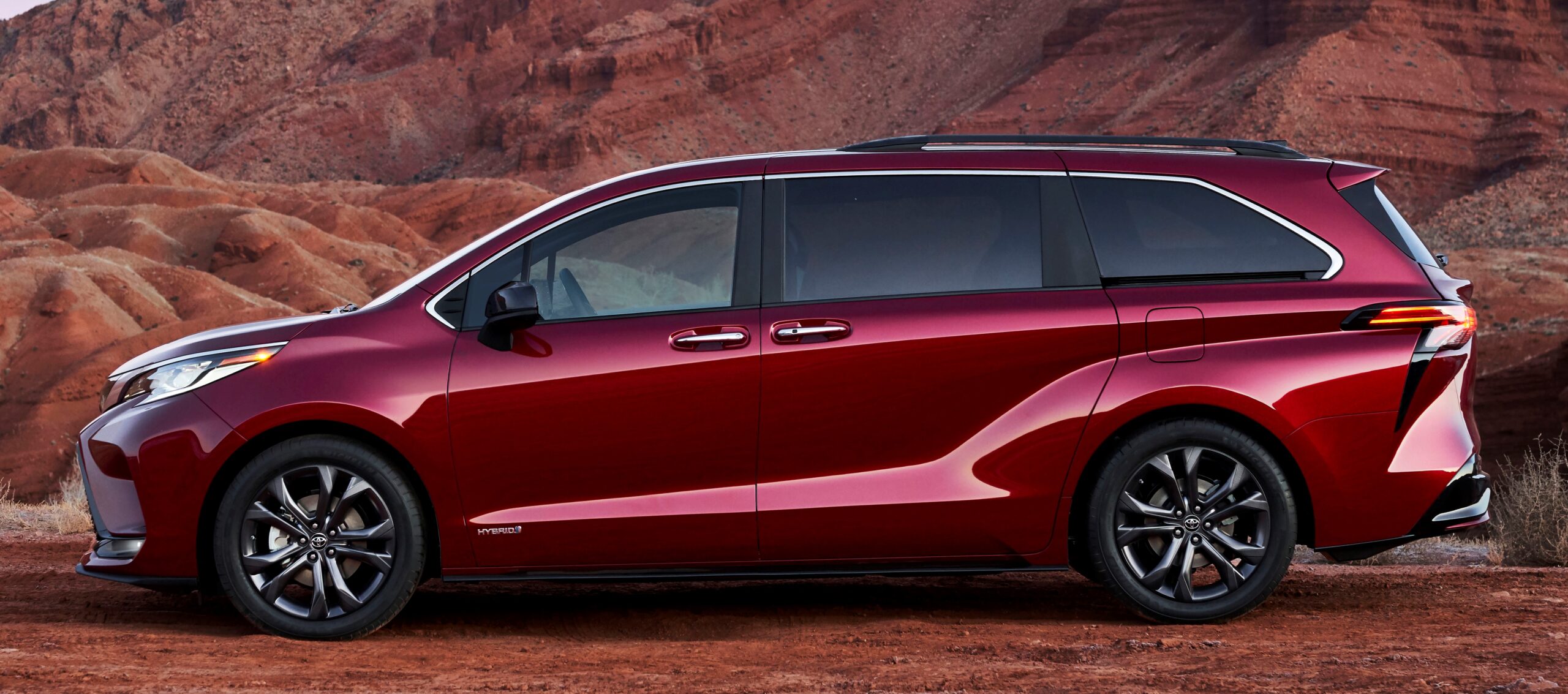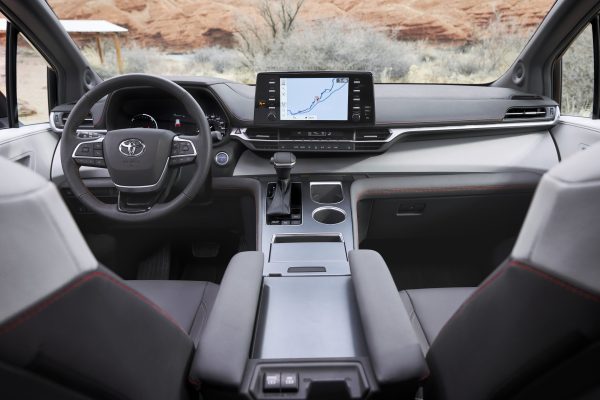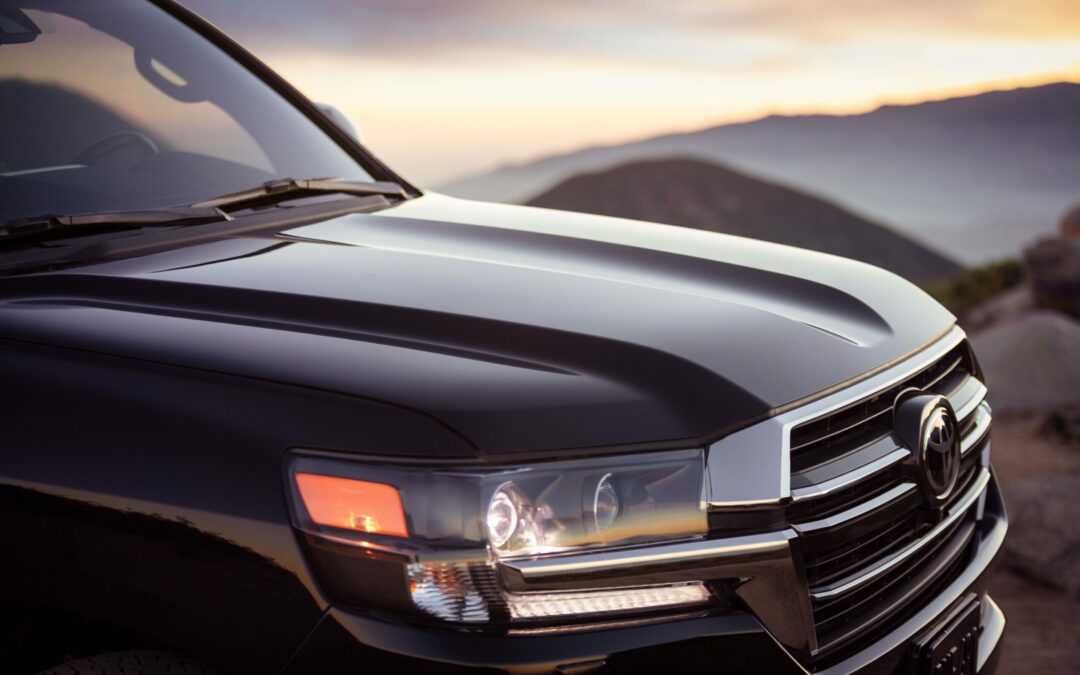The turbocharged, four-cylinder 2021 Toyota GR Supra 2.0 is a genuine sports car with a German pedigree, high-quality engineering, and robust construction
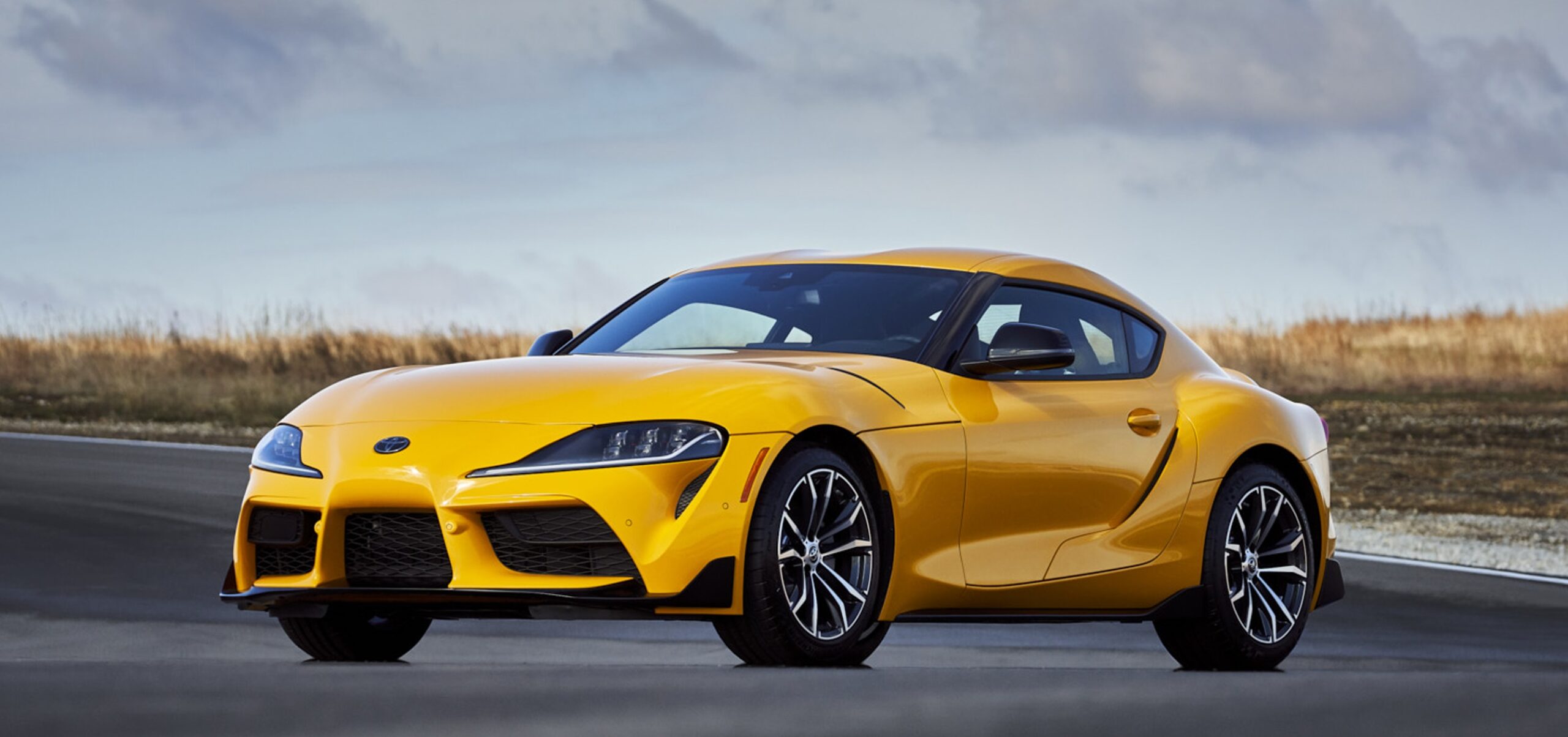
The turbocharged, four-cylinder Toyota GR Supra 2.0 is new for 2021. Pricing starts at $44,215. (Photography courtesy of Toyota)
Table of Contents
Supra History
GR Supra Sport Top
What’s New for 2021-22?
Pricing
GR Supra A91-CF Edition
GR Supra GT4 Race Car
GR Supra 2.0 Performance
Ride and Handling
Interior Function
Why Buy the Toyota GR Supra 2.0?
Specifications
BY MARK MAYNARD
The return of the fifth-generation 2020 Toyota Supra was an act of blasphemy some enthusiasts shouted. The objection was the joint venture between BMW and Toyota. It was an arranged marriage for the diverse qualities of future development and shared costs.
BMW would benefit from Toyota’s long-term work on alternative-fuel propulsion systems, including a fuel cell. Toyota would reap the rewards of the German carmaker’s expertise in lightweight technologies. And the face of the deal would be represented by the joint development of a sports “vehicle,” which became the 2020 GR Supra.
The howls of discontent were heard before most enthusiasts even sat in the reborn Japanese two-seater.
Joint ventures are becoming common in the auto industry. For example, Toyota also partners with Subaru for its BRZ and Toyota GR86. And there also is the Mazda MX-5 Miata and Fiat 124 Spider.
It is a matter of cost-sharing, but is the BMW-Toyota arrangement a collaboration or a compromise?

Eight-way manually adjusted seats save weight in the GR Supra 2.0.
Toyota Supra History
The fifth generation of the brought-back Supra nameplate dates to the lineup from 1978 to 2002. But Toyota also credits the 1967 2000GT with its double-bubble roof and inline six-cylinder engine, two hallmarks applied to the 2020 Supra.
While the first four generations of Supra shared a foundation with Toyota’s sporty Celica,
the current model shares a foundation with the BMW Z4. For now, BMW keeps the Z4 convertible and Toyota builds a hardtop version with performance engineering from its Gazoo Racing team (GR).
The Z4 is an excellent beginning for a two-seat, rear-wheel-drive sports car. Toyota’s follow-through for the hardtop design provides an ideal 50:50 weight balance. Engineering calibrations for the engine, suspension, and exhaust provide excellent road adhesion. Ride quality has steely determination without battering the occupants.
Automotive News reports that the Toyota GR Supra is due for a “freshening” in 2023.
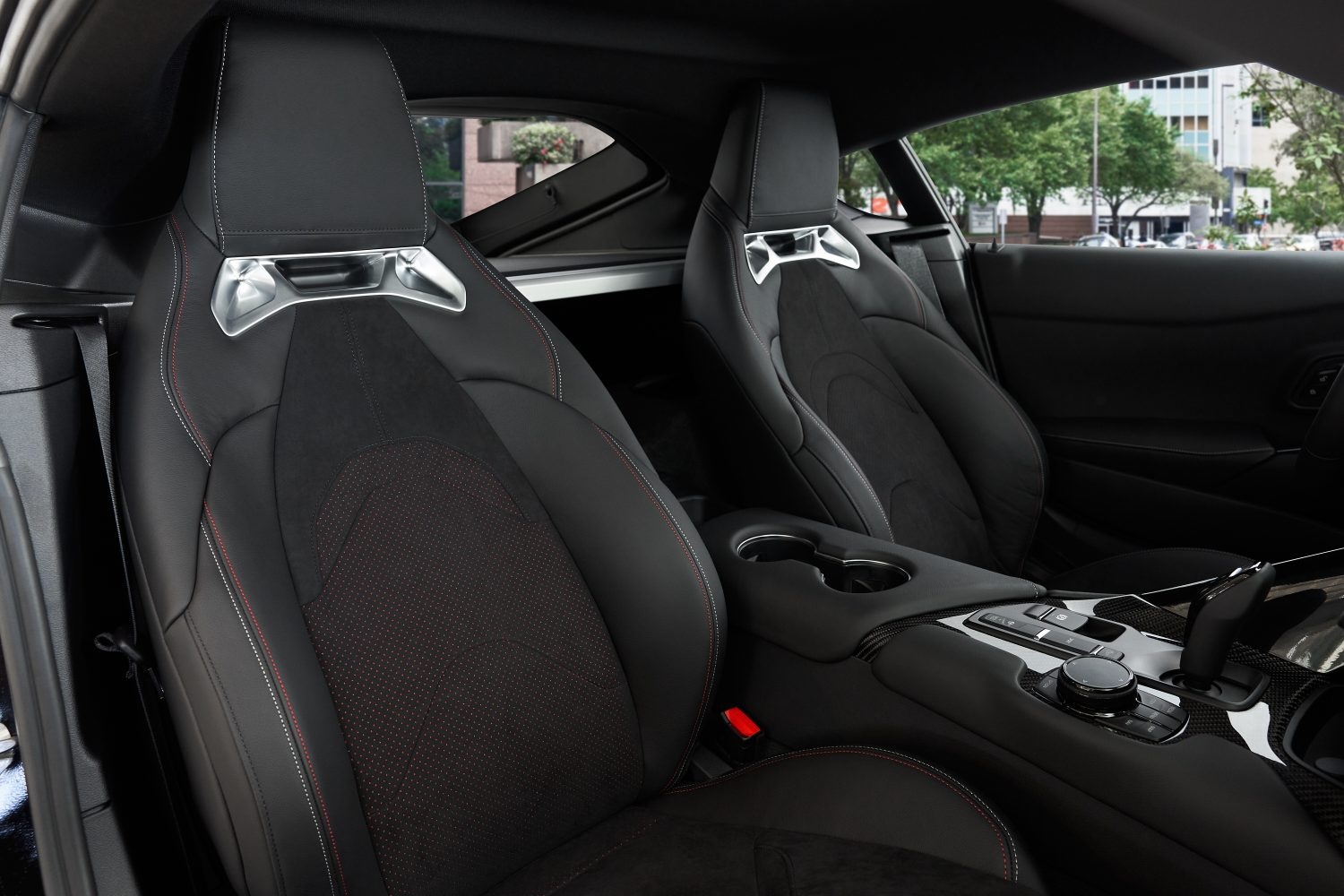
Black Alcantara and leather-trimmed upholstery
GR Supra Sport Top
Perhaps the 2023 “freshening” could bring a convertible GR Supra?
Toyota showed the GR Supra Sport Top at this year’s Specialty Equipment Manufacturers Association (SEMA). The roof design has two composite panels that were 3D printed. And the roof panels are contoured to the body lines and the design retains the windshield header.
To maintain structural integrity, the roof’s outer body structures were reinforced. And there is added reinforcement under the engine bay and rearward.
The SEMA show will run from Nov. 2-5 in the Las Vegas Convention Center.

The GR Supra Sport Top concept.
What’s New for 2021-22?
A year after its world debut, Toyota has grown the GR Supra family at both ends: an entry-level turbocharged four-cylinder model and a high-performance halo model.
For the first time in the U.S., Toyota has been able to add the 255-hp, 2.0-liter four-cylinder engine, formerly only available in the BMW Z4.
At the top end is the shut-up sauce for GR Supra complainers: the GR Supra A91-CF (Carbon Fiber) Edition, $64,305. This 2022 model includes a carbon fiber aerodynamics kit, 382-hp 3.0-liter inline six-cylinder engine, and a one-year membership to the National Auto Sport Association with high-performance driving instruction.
Limited to just 600 vehicles, the GR Supra A91-CF is well equipped with just one factory option for the Driver Assist Package, $1,195.
And in between the price range are two six-cylinder models. This year the GR Supra 3.0 and 3.0 Premium were granted horsepower to match the 382-hp in the Z4 M40i. Previously, the six-cylinder models were throttled back to 335 horsepower from 5,000-6,500 rpm with peak torque of 365 foot-pounds at 1,600 rpm. Now, peak horsepower ranges from 5,800-6,500 rpm and peak torque is 368 lb.-ft. from 1,800-5,000 rpm.

The “S” in the Supra logo was inspired by the Nürburgring “S” curve.
GR Supra Pricing
The fifth-generation 2021 GR (Gazoo Racing) Supra is offered in two turbocharged powertrains: a 255-hp 2.0-liter four-cylinder or 382-hp, 3.0-liter inline six-cylinder. Both versions have an eight-speed ZF-8 automatic transmission with paddle shifters.
Current GR Supra pricing ranges from $44,215 for the entry 2.0-liter to $64,305 for the A91-CF Edition. Pricing includes the $1,025 freight charge from Graz, Austria. The Supra is built at the Magna Steyr plant, which also builds the BMW Z4 among other specialty vehicles.
Today’s GR Supra 2.0 tester was $47,845, including a carpeted cargo mat for $80, wheel locks for $65, and the Safety & Technology Package for $3,485. (Package details are in the specifications chart at the end of this review.)
BMW sells just two versions of the Z4 roadster. The Z4 sDrive30i with the 2.0 turbo four-cylinder starts at $50,895. And the Z4 M40i, with 382-hp 3.0-liter inline six-cylinder starts at $64,695. (But Toyota includes more standard equipment for the GR Supra.)
Check current Toyota GR Supra pricing and incentives here.

The double-bubble roof design bumps headroom to 38.3 inches.
Toyota GR Supra A91-CF Edition
Limited to just 600 cars, the GR Supra A91-CF Edition is the most exclusive Mark V Supra to date, Toyota says, and it’s only for North America.
The 2022 GR Supra A91-CF features a carbon fiber front splitter and larger canards (winglet-like add-ons). In addition, carbon fiber side rockers define the lower edge along the sides. And around the back, there is more carbon fiber in the duckbill spoiler and lower canards.
This aero kit isn’t just for looks, Toyota says. The design improves downforce and stability, whether scooting through the daily commute or hot-lapping the autocross.
Other special features include matte-black textured 19-inch wheels — chosen to set off the optional new paint color of matte-gray Phantom. Absolute Zero White and Nitro Yellow are the other color choices for the GR Supra A91-CF.
GR Supra A91 A91-CF Edition has a red-and-black interior theme throughout its Alcantara-and-leather-trimmed cabin. Details include red stitching on the 14-way power-adjustable and heated sport seats, carbon-fiber interior trim, a leather-wrapped three-spoke steering wheel, and sport pedals.
A range of standard intelligent safety features includes a pre-collision system with pedestrian detection and lane departure warning with steering assist.
And every new owner is given a one-year membership to the National Auto Sport Association with high-performance driving instruction.

Limited to just 600 cars, the GR Supra A91-CF Edition is the most exclusive Mark V Supra to date and only for North America.
The 430-hp GR Supra GT4
There also is a race-prepped GR Supra GT4 for customer teams. It is based on the six-cylinder GR Supra and is developed and produced by Toyota Motorsport GmbH.
The GR Supra GT4 is powered by a 430-hp variant of the 3.0-liter inline six-cylinder engine with a single twin-scroll turbocharger. A seven-speed sports automatic transmission has paddle shifters and a mechanical limited-slip differential. An Akrapovič exhaust system is standard, and Ravenol provides first-fill lubricants.
The front splitter and rear wing are made of natural fiber composite, contributing to an overall weight of 2,976 pounds, which is 424 pounds less than a stock GR Supra 3.0. As is used for the GR Supra road car, the front suspension has MacPherson struts, and the rear multilink suspension uses KW dampers at the front and rear.
An enhanced braking system uses six-piston front calipers and four-piston rear, with tires by Pirelli.
Safety features include a high-strength roll cage on the lightweight steel body and an FIA-standard racing seat with a six-point harness.
The interior has a carbon-fiber instrument panel with a display and a steering wheel designed for GT4 competition.
Pricing starts at around $200,000. Contact TRD at trdusa.gt4@toyota.com to get more information on the GR Supra GT4.

The GR Supra GT4 is powered by a 430-hp, 3.0-liter inline 6-cylinder engine.
GR Supra 2.0 Performance
At 3,181 pounds, the Supra 2.0 is more than 200 pounds lighter than the six-cylinder Supra 3.0. And that weight difference significantly changes the driving attitude of the car, in a positive way. The six-cylinder models are ate-up with power, which sometimes blows past the pleasure of feeling a German-engineered suspension make its graceful transitions.
With less weight over the front end, the Supra 2.0 feels nimble and quick. Throttle uptake is immediate without time lost to turbo spooling. And the engine tone and exhaust note are genuine for a performance car. There is not the high-speed drone of artificially generated engine “sound” that switches on and off.
In standard performance mode, the eight-speed automatic rolls through gears giving eager support to the driver. In Sport mode, the transmission has mind-reading precision, holding shifts for maximum enjoyment and giving heady downshifts.
Various sources cite 0-60 mph acceleration in 4.7 seconds for the GR Supra 2.0. And that compares to 4.4 seconds to reach 60 mph in the Supra 3.0 models. If valid, that 0.3 advantage for the 3.0 models comes at a cost difference of $8,350.
Fuel economy ratings are 25 mpg city, 32 highway and 28 mpg combined on the recommended premium fuel. (Those ratings compare to the six-cylinder model at 22/30/25 mpg.) My driving with liberal use of Sport mode worked up to 27.5 mpg, but I was focused more on fun than fuel economy.

Rear combination lamps feature the turn, tail, and stop functions integrated into a ring shape.
Ride and Handling
The GR Supra is surprisingly uncomplicated to enjoy. It is an excuse to take the long way to work or to head out for weekend exploring. But it would not be my choice for a long road trip. It has a tight cockpit and the outside noise can be wearisome. However, the sport seats would remain comfortable for the range of the 13.7-gallon fuel tank.
After a few miles behind the wheel, the driver will warm up to the balance of the GR Supra 2.0. It is a rewarding engineering asset. The articulation of the suspension is a delicious experience as it stealthily makes weight transitions. Both powertrains have the same four-wheel-independent suspension with front MacPherson struts and a five-link rear setup. Stabilizer bars are the same gauge all around: 23.5 mm front and 18 mm rear.
Brush the brake pedal when barreling into a corner and the transmission flashes a downshift. Press harder on the pedal and downshifts fire off sequentially.
It is an active and engaging experience for the driver who will quickly forgive and forget that no manual gearbox is offered.
The electric power steering is keenly calibrated for an organic feel and smooth roll of the steering wheel. It takes just a twitch of the wheel to make a lane change, which brings yet another smile.
Despite the low front end, careful steering can avoid the occasional grind (and wince) of chin scraping.
Tires and Brakes
All Supra models get Michelin Pilot Super Sport staggered-size, ultra-high-performance tires. The Supra 2.0 has 18-inch alloy wheels with 255/40 front and 275/40 rear tires. And the Supra 3.0 has 19-inch forged aluminum wheels and slightly wider tires of 255/35 front and 275/35 rear.
Braking is by a matched set of 13-inch vented discs front and rear with a single-piston aluminum floating caliper. Six-cylinder models get 13.7-inch ventilated front discs with a four-piston fixed Brembo caliper; rear ventilated discs are 13.6 or 13 inches, depending on which model.

Braking is by 13-inch vented discs front and rear. Six-cylinder models get 13.7-inch vented front discs and a four-piston Brembo caliper.
Interior Function
For such a high-performing car, it is accommodating as a daily driver. The shrink-wrapped body with a double-bubble roof allows headroom of 38.3 inches. With 42.2 inches of legroom and the eight-way manually adjusted seats, there should be room for those 6-feet-plus, but maybe not while wearing a helmet.
The seat-belt anchors are low and can be a struggle to click into position, competing for space with the bolstered seatback. Those of large girth will grumble about the extra effort to secure the belt, but the low anchor position actually improves the safety response.
Standard safety features include eight air bags, a precollision system with pedestrian alert and lane-departure warning with steering assist. Other safety elements are in the specs chart at the end of the story.
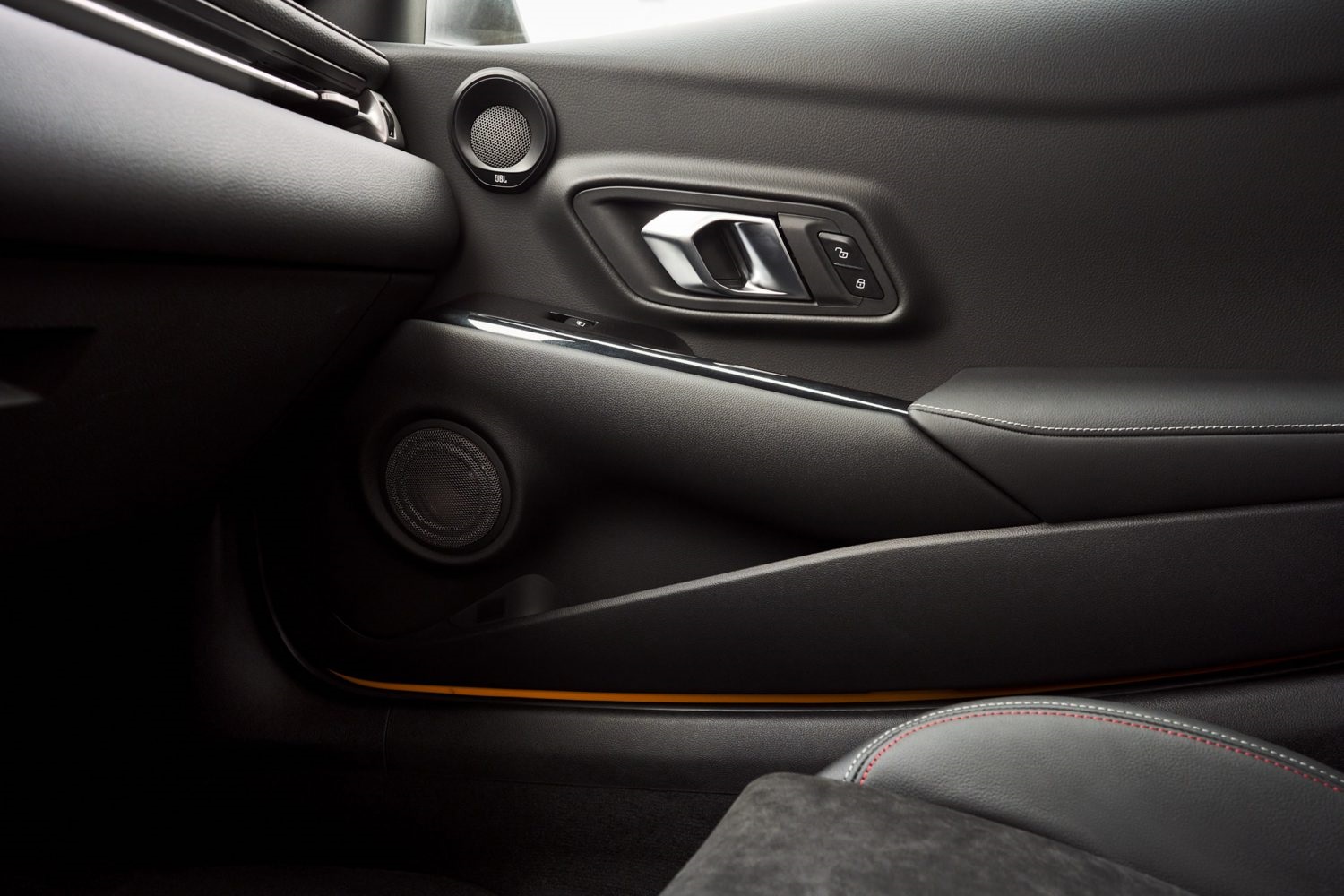
Interior assembly and materials are worthy of a $50,000 sports car.
Entry and Exit
The car is low with a wide sill that creates a duck-and-drop entry exercise. And those coupe doors are about 54 inches long, which is not an asset for access in tight parking situations. Finally, because the point of the spear is about 9 feet from the driver’s seat, I wished for a front camera (as in the Corvette) — in addition to the front and rear parking tones (with braking).
Sightlines out the front are good but compact out the small rear glass. Over-the-shoulder glances are blocked and damning at night. The rearview camera is small but helpful.
Cabin design is smartly organized with several areas for small-item storage, including a lockable glove box. The shift console is somewhat unique for its knee-bolstering brace on the driver’s right, and the left side is an open sweep that creates a sense of involvement for the passenger.
A bold and uncluttered gauge array has a dominant dial for RPMs and a digital speedo.
The 10.2 cubic feet of trunk space is adequate for weekend-getaway luggage.
Why Buy the Toyota GR Supra?
When you give an enthusiast a choice of more power or less, most will choose “more.” But the GR Supra 2.0 is not a cheapened model for a more appealing advertising price point.
The GR Supra 2.0 is a genuine sports car with a German pedigree, high-quality engineering, and robust construction.
Working with BMW is a blue-chip opportunity. The Z4 is a Thoroughbred in critical areas where some brands cheap out.
Toyota took the opportunity and built a family of GR Supras. The compromise might be for BMW, which has just the two Z4 roadster models.
Sales on average for the BMW Z4 convertible run about 280 a month, or 833 for the third quarter ending in September.
Supra sales in September were 436 (but down from 489 in Sept. 2020). But year to date Supra sales were 5,825 vs. 3,798 for 2020.
Maybe BMW will see Toyota’s positive business plan and be granted a hardtop Z4.
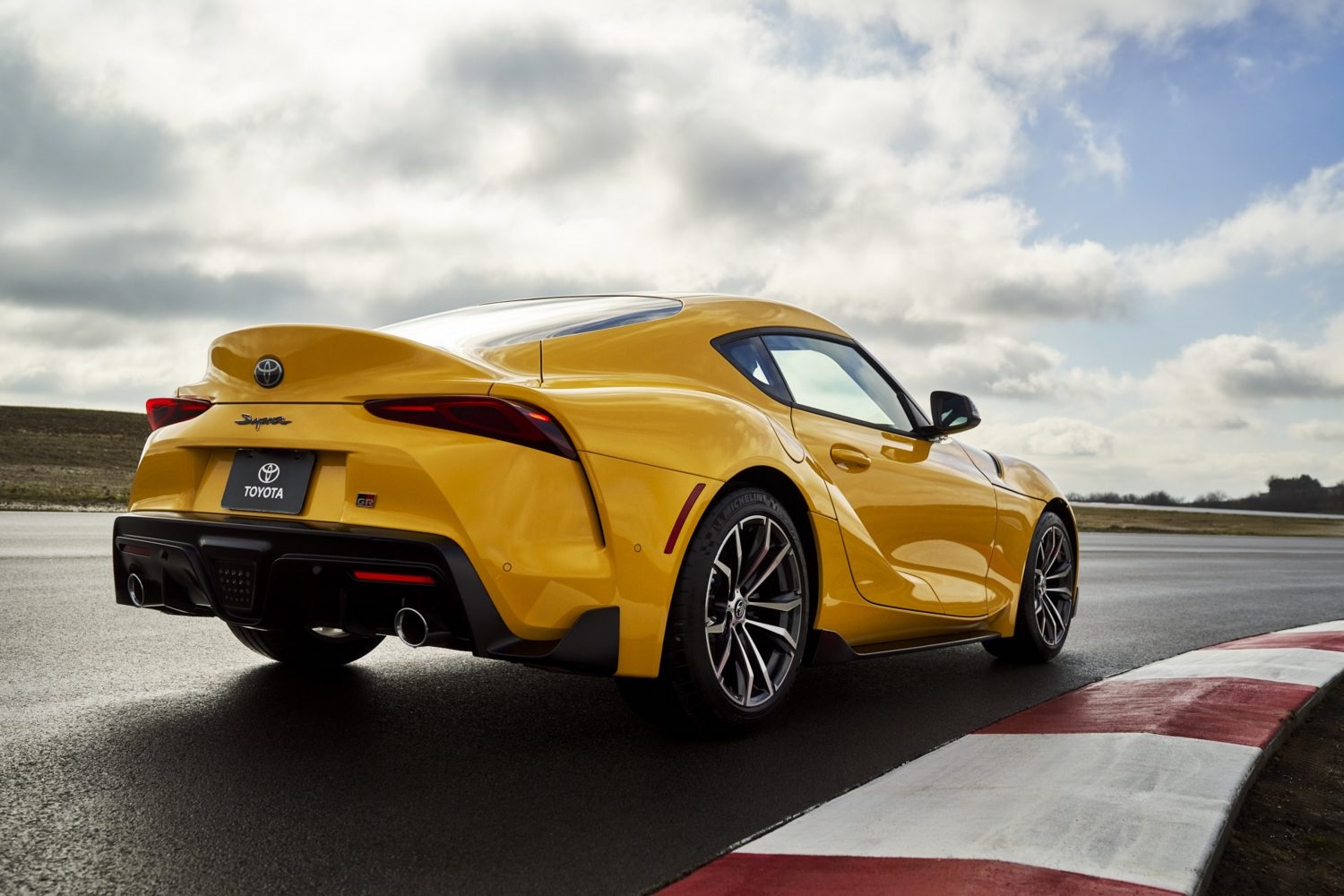
Automotive News reports that the Toyota GR Supra is due for a “freshening” in 2023.
Toyota Supra GR 2.0 Specifications
Body style: subcompact, rear-wheel-drive, 2-seat sports car
Engine: 255-hp, twin-scroll turbocharged direct-injected 2.0-liter, inline 4-cylinder; 295 lb.-ft. from 1,550-4,400 rpm
Transmission: 8-speed automatic with paddle shifters and launch control; active rear differential
0-60 mph: 4.7 seconds, Car and Driver magazine
Fuel economy: 25/32/28 mpg city/hwy/combined; premium fuel recommended
BY THE NUMBERS
Fuel tank: 13.7 gallons
Trunk space: 10.2 cubic feet
Head/leg room: 38.3/42.2 in.
Length/wheelbase: 172.5/97.2 in.
Curb weight: 3,181 lbs.
Turning circle: 34.1 ft.
FEATURES
Standard equipment includes: Smart key entry with push-button ignition, electric parking brake, rearview camera with guidance lines, 8.8-inch full digital gauge cluster, 8-way manual seats with 4-way lumbar, black Alcantara with leather sport seats, carbon-fiber interior trim, leather-wrapped 3-spoke steering wheel with paddle shifters, lined and locking glove box, 12-volt charging socket and 1.5-amp USB port, 4 speaker audio system with an 8.8-inch display screen with Supra Command and USB/Bluetooth connectivity
Exterior: 18-inch alloy wheels with Michelin Pilot Super Sport staggered size ultra-high-performance tires (255/40 front and 275/40 rear), gloss-black auto-folding heated side mirrors, LED front turn signal indicator and daytime running lights, 6-lens auto-leveling LED headlights (3 low beam, 3 high beam), LED tail lights and brake lights, aerodynamic underbody panel, dual rear exhaust outlets with polished stainless-steel tips
Safety features include: 8 air bags, precollision system with pedestrian alert, lane-departure warning with steering assist, auto high-beam headlight dimming, hill-start assist, brake assist, stability and traction controls
PRICING
Base price: $44,215, including $1,025 freight charge; price as tested $47,845
Options on test vehicle: Carpeted cargo mat $80 and wheel locks $65;
Safety & Technology Package, $3,485, include: Dynamic Radar Cruise Control (full speed), blind-spot monitor, rear cross-traffic alert, parking sensors with emergency braking function;
Technologies included in the package: 8.8-inch touchscreen navigation, 12 Speaker 500-watt JBL audio system with amplifier, touchpad rotary controller, wireless Apple CarPlay compatible (iOS only), speed limit information;
Supra Connected Services with up to 4-year trial: Included are remote services, remote maintenance, automatic emergency call, real-time traffic information, concierge, stolen vehicle recovery, map updates
Where assembled: Graz, Austria
Warranties: 3 years/36,000 miles bumper to bumper; 5 years/60,000 miles powertrain; ToyotaCare complimentary maintenance for 2 years/25,000-miles, includes all standard factory scheduled service and 24/7 roadside assistance

































